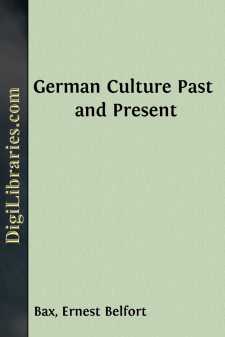Categories
- Antiques & Collectibles 13
- Architecture 36
- Art 48
- Bibles 22
- Biography & Autobiography 813
- Body, Mind & Spirit 142
- Business & Economics 28
- Children's Books 17
- Children's Fiction 14
- Computers 4
- Cooking 94
- Crafts & Hobbies 4
- Drama 346
- Education 46
- Family & Relationships 57
- Fiction 11829
- Games 19
- Gardening 17
- Health & Fitness 34
- History 1377
- House & Home 1
- Humor 147
- Juvenile Fiction 1873
- Juvenile Nonfiction 202
- Language Arts & Disciplines 88
- Law 16
- Literary Collections 686
- Literary Criticism 179
- Mathematics 13
- Medical 41
- Music 40
- Nature 179
- Non-Classifiable 1768
- Performing Arts 7
- Periodicals 1453
- Philosophy 64
- Photography 2
- Poetry 896
- Political Science 203
- Psychology 42
- Reference 154
- Religion 513
- Science 126
- Self-Help 84
- Social Science 81
- Sports & Recreation 34
- Study Aids 3
- Technology & Engineering 59
- Transportation 23
- Travel 463
- True Crime 29
German Culture Past and Present
Description:
Excerpt
INTRODUCTORY
The close of the fifteenth century had left the whole structure of mediæval Europe to all appearance intact. Statesmen and writers like Philip de Commines had apparently as little suspicion that the state of things they saw around them, in which they had grown up and of which they were representatives, was ever destined to pass away, as others in their turn have since had. Society was organized on the feudal hierarchy of status. In the first place, a noble class, spiritual and temporal, was opposed to a peasantry either wholly servile or but nominally free. In addition to this opposition of noble and peasant there was that of the township, which, in its corporate capacity, stood in the relation of lord to the surrounding peasantry.
The township in Germany was of two kinds—first of all, there was the township that was "free of the Empire," that is, that held nominally from the Emperor himself (Reichstadt), and secondly, there was the township that was under the domination of an intermediate lord. The economic basis of the whole was still land; the status of a man or of a corporation was determined by the mode in which they held their land. "No land without a lord" was the principle of mediæval polity; just as "money has no master" is the basis of the modern world with its self-made men. Every distinction of rank in the feudal system was still denoted for the most part by a special costume. It was a world of knights in armour, of ecclesiastics in vestments and stoles, of lawyers in robes, of princes in silk and velvet and cloth of gold, and of peasants in laced shoe, brown cloak, and cloth hat.
But although the whole feudal organization was outwardly intact, the thinker who was watching the signs of the times would not have been long in arriving at the conclusion that feudalism was "played out," that the whole fabric of mediæval civilization was becoming dry and withered, and had either already begun to disintegrate or was on the eve of doing so. Causes of change had within the past half-century been working underneath the surface of social life, and were rapidly undermining the whole structure. The growing use of firearms in war; the rapid multiplication of printed books; the spread of the new learning after the taking of Constantinople in 1453, and the subsequent diffusion of Greek teachers throughout Europe; the surely and steadily increasing communication with the new world, and the consequent increase of the precious metals; and, last but not least, Vasco da Gama's discovery of the new trade route from the East by way of the Cape—all these were indications of the fact that the death-knell of the old order of things had struck.
Notwithstanding the apparent outward integrity of the system based on land tenures, land was ceasing to be the only form of productive wealth. Hence it was losing the exclusive importance attaching to it in the earlier period of the Middle Ages. The first form of modern capitalism had already arisen. Large aggregations of capital in the hands of trading companies were becoming common....


